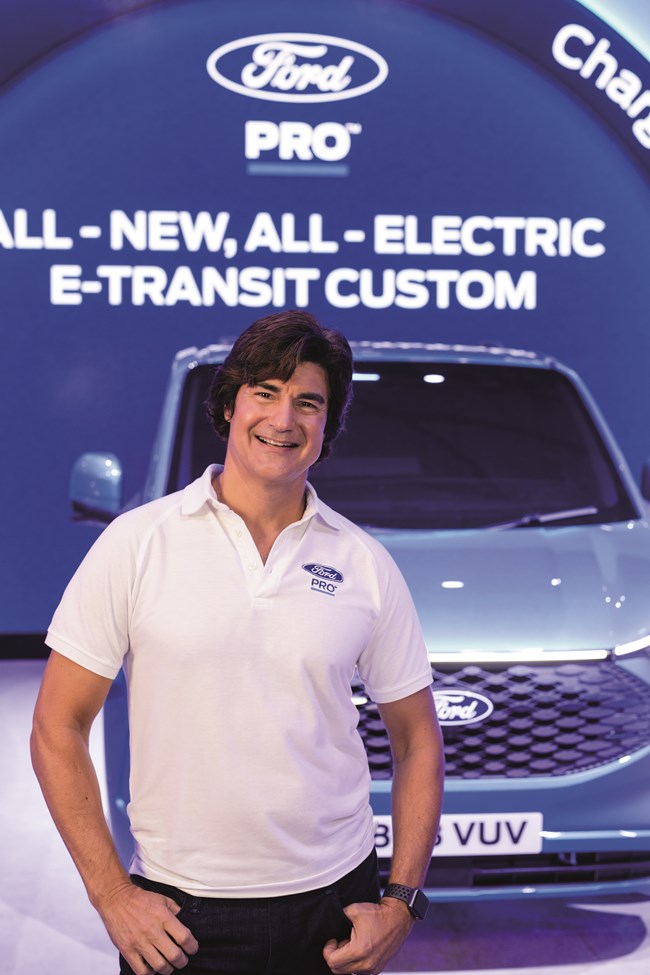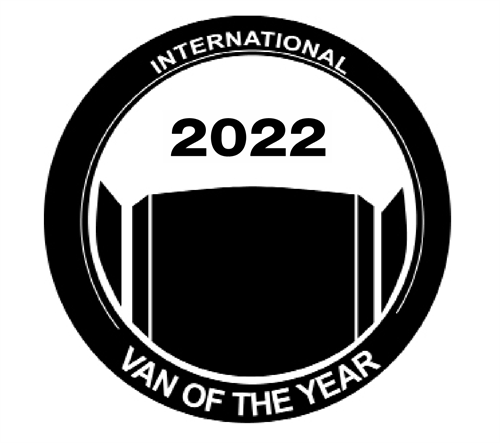- ETRUX launches new Ford E-Transit Trizone
- Renault gives UK debut to Master E-Tech at CV Show
- Isuzu D-Max long-term test – Latest Report
- Isuzu D-Max V-Cross Steel Edition revealed
- IVOTY Report: Stellantis explores the hydrogen proposition
- New Maxus EVs include eDeliver 5 van
- Used LCV values reach six-month high
- ADVERTISEMENT FEATURE: IVECO Daily Mission Awards 2024 Q2 Round-up: Grounds Maintenance & Forestry
- Stellantis Pro One electric vans review
- Mitie adds 5,000th EV to fleet
IVOTY Analysis: Ford embraces software solutions
Date: Monday, November 7, 2022 | Author: George Barrow
The Blue Oval’s LCV boss steers a path towards electrification during ‘an awesome time to be in the business’.

A lot has been changing at Ford recently. On a global level, there’s been a seismic shift towards electric vehicles with the Mustang Mach-E and Ford F150 Lightening becoming standard bearers for Ford’s electrification.
The man partly responsible for that transformation is Ted Cannis, who from late 2017 to May 2020 was global director of battery electric vehicles, leading the strategy and business execution for Ford’s dedicated battery electric vehicles programme, Team Edison, and responsible for the development of the Mach-E, a team which later had a role in the creation of the F-150 Lightning and E-Transit.
However, since June 2021 Cannis has overseen commercial vehicles having taken on the role of CEO of Ford Pro. Reporting directly to Jim Farley, president and CEO of Ford, Cannis is spearheading Ford’s push in to connected services and new electric vehicles.
Having recently unveiled the E-Transit Custom, Ford’s second of five confirmed electric vans that include the two-tonne E-Transit, one-tonne E-Transit Custom, E-Tourneo Custom and next generation Transit Courier van and Tourneo Courier due in 2024, the focus is now on the eco-system around the electric products.
“I think the real part is the software. It’s harder and not easy to put into motion, but you can start to learn what it is that people do. It’s kind of like with a website, do the people turn to the blue picture or the red picture? All of that becomes data. Now the [vehicle] is the data and with customer consent it’s going to give more and more data off. Now you’re going to know the usage patterns: how often do they roll the windows up and down, how is the vehicle being used for that delivery? It’s those minutiae and details or repetition of tasks; for safety, for worker ergonomics, for ingress/egress. That’s what you can learn a lot through the data and software. And then you can fix it,” Cannis explains.
This approach to, and application of, massive data gathering is not new for the automotive industry but for Ford it is a stepping-stone to providing something for the customers that others cannot.
The new architecture of the Ford Pro Upfit Integration System – a module that provides a direct connection to the electrical system for converters that can then be controlled via in-built touchscreen rather than though bolt-on switchgear – is just one example of how Ford Pro is looking at and understanding how its products are being used and adapting solutions for its customers. The same can be said of the E-Transit Custom’s tilting steering wheel with attachable dinner plate-like surface to allow you to use a laptop or make a table to eat at in the driver’s seat. The major difference is that data will be informing those decisions going forward and ultimately the data usage will help direct product, and more importantly software development towards autonomous vehicles.

“Autonomy is just replacing driving. But for a commercial customer, you’ve got the upfits [conversions] and everything else to think about. Today, you kind of plug-in but it’s very hard to get through the firewall of the vehicles, you have all of these tiny wires. This new system is basically an app-based system, which will allow you to talk to the vehicle as a converter through safety situations and control the vehicle,” says Cannis.
The immediate focus is on the physical improvements that can be made to the Ford vans and ecosystem, while also feeding into the bigger picture of future vans. Yet the Ford Pro software systems are already yielding benefits, integrating existing platforms into customers’ daily work routines. Cannis gives the example of the Salesforce Field Service CRM system being integrated with Ford Pro’s new VIZR software system to allow tradespeople to schedule appointments and send invoices through an integrated cloud-based system. In simple terms Cannis says: “The customer gets data software to improve productivity and Ford gets recurring revenues as software services”.
While the proposition might sound slightly cynical when spelled out, the hope is that it will help maintain an association with the brand. With electric vehicles requiring less servicing, there will inevitably be fewer dealer interactions for customers, but brand identity and loyalty will be created by utilising these value-added services for customers. Indeed, Cannis says that servicing for electric vehicles will become increasingly mobile with fleets opting to have several vehicles all dealt with at their depot rather than individually taking them to a dealership.
A total of 75,000 repairs have been completed in the UK alone by mobile service vans.
The combination of on-board software informing customers or Ford dealers is only part of the picture. Customers are increasingly coming to Ford to ask it to solve daily problems and it is the software providing the solutions.
Cannis gives the example of a customer who operated a Transit with ladders on roof bars who wanted to have all height restricted roads blanked out in the navigation. Because of the software, Ford Pro was able to do that for them, saving them costly repairs and downtime.
“It automatically clears all the maps. That looks really cool, and it’s a good thing. It’s an awesome time to be in the business,” he says.
The long term aim is a greater push towards electrification. Success like E-Transit and F150 Lightning have galvanised the strategy and software solutions are now not only becoming the icing on the cake but a new proposition entirely.
“I think the next year this double transition, electrification and software, of which I think software is going to be bigger, it is huge. Everybody’s talking about sustainability. So that’s going to happen, but the automation and creation of productivity tasks is going to be amazing. It’s kind of like those early days of websites. It just changed everything.”
Ford unleashes its Lightning rod
Occasionally, I get to drive something truly special and the Ford F150 Lightning definitely falls into that category. The Lightning is a symbol of Ford’s remarkable and rapid turnaround of new electric vehicles, transforming North America’s most iconic and best-loved workhorse, the F150, into a zero-emission pick-up that secured 200,000 reservations inside six months with 70,000 of those coming in the first four days.
It has two electric motors to give you all-wheel-drive, up to 570hp and 1,050Nm of torque. Tipping the scales at nearly three tonnes, it is quite frankly amazing that it can dash from 0 to 60mph in just 4.3 seconds and still serve up a claimed range of 320 miles from the extended battery thanks to a massive 131kWh battery. Even in the real world, making regular use of all that power, the range is still at least 240 miles. It can tow 4.5 tonnes and has a one-tonne payload capacity. Then there’s the Lightning’s party piece, The Frunk: A 400-litre loadspace that can hold 180kg.
It rides magnificently for such a large truck, and the handling is sharp and responsive too. It feels big, but it doesn’t feel heavy or cumbersome, which is daft because it is both. It’s also loaded with tech from the 15.5in multimedia screen down to the massage seats. Not to mention the 9.6kW of on-board power and a multitude of sockets located everywhere from front to back, enabling you to run every conceivable tool off it.
At 2.4m wide, it’s not exactly sensible to own one in the UK (and there are no plans for a right-hand-drive version anyway) but you’d still want to.
Prices did start from $39,974 (£36,206) at launch, but have jumped to $51,974 for 2023 models, however, it still feels like good value. Even the $97,000 needed to get the top spec Platinum model I tested seems like good value when you compare it to other electrified performance SUVs like the Tesla Model X.
With the new Ranger chassis capable of taking both petrol and diesel powertrains, we’d hope it might be possible to fit some electric underneath too. If this is the future of electric pick-up trucks then form an orderly queue behind me because I will be first in line.
George Barrow is the UK judge for the International Van of the Year, the prestigious prize awarded by leading European LCV journalists.
View The WhatVan Digital Edition


